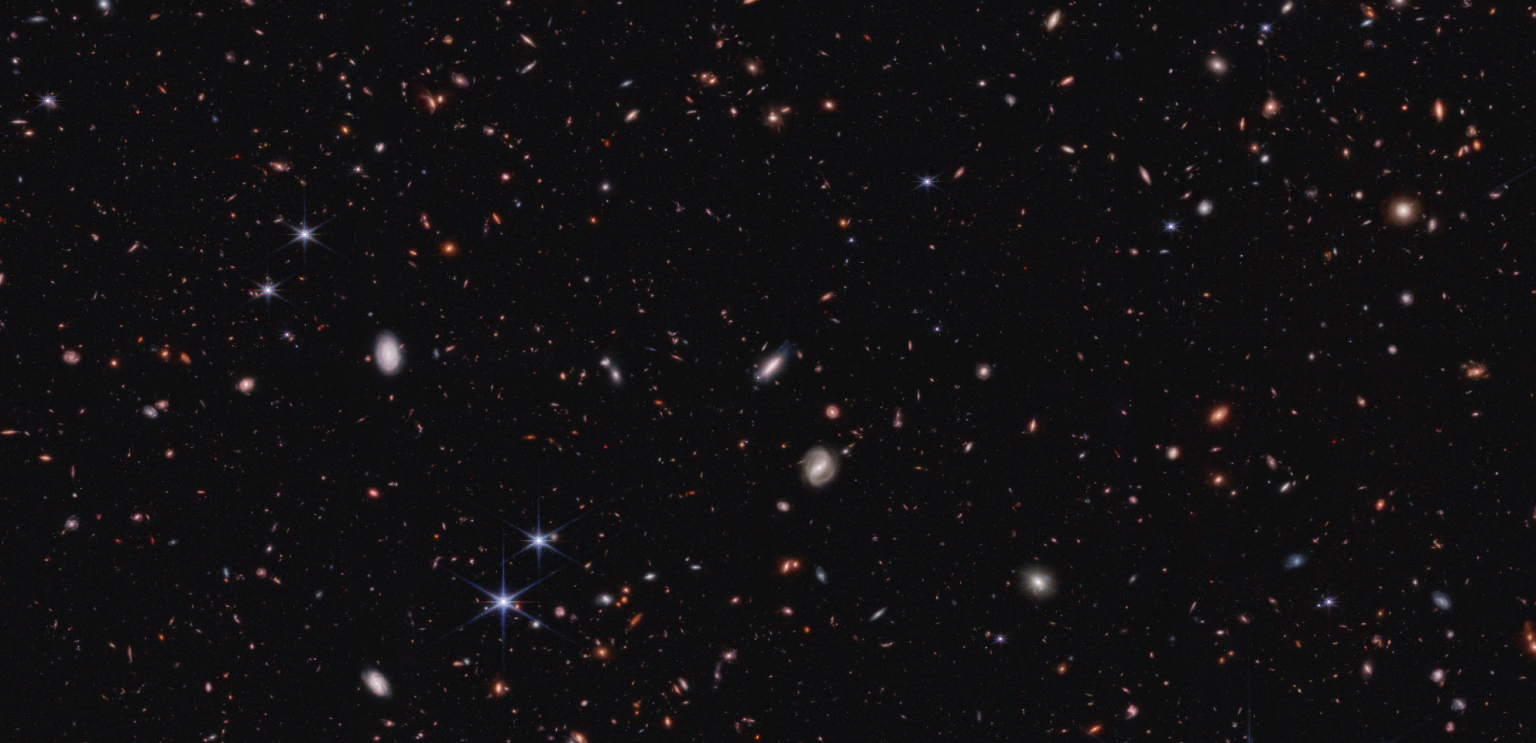The early Universe continues to spring surprises on astronomers. In a recent study of dim, distant objects, astronomers at the University of Missouri found at least 300 of them that look way too bright. That means they’re forming stars much earlier than expected, or something else is going on. Whatever it is could affect our understanding of events in the infant cosmos. The astronomers used two of JWST’s powerful infrared cameras: the Near-Infrared Camera and the Mid-Infrared Instrument. Both are specifically designed to detect light from the most distant places in space, which is key when studying the early Universe.
“These mysterious objects are candidate galaxies in the early Universe, meaning they could be very early galaxies,” said Haojing Yan, an astronomy professor in Missouri’s College of Arts and Science and co-author on the study. “If even a few of these objects turn out to be what we think they are, our discovery could challenge current ideas about how galaxies formed in the early Universe – the period when the first stars and galaxies began to take shape.”
Early, IR-bright objects found the Ultra-deep Survey (UDS) regions of the sky, featuring multi-wavelength data taken by both Hubble Space Telescope and the James Webb Space Telescope. JWST, in particular, is sensitive to infrared light from very dim, distant objects in the early Universe.
Seeing into the Past
The big exploration challenge with the youngest objects in the Universe is that astronomers can’t just check them out quickly through a telescope and say, “Aha!” and explain what they’ve found. It’s not easy to study this epoch of cosmic history, thanks to distance and dimness. To determine exactly what these objects were, Yan and his colleagues had to take a step-by-step approach. It takes multiple observations in various wavelengths of light to confirm just where and when these things existed in cosmic history.
In particular, the team used something called the “dropout technique” to study each of the 300 galaxies in their sample. That method depends on observations of the same objects in different wavelengths of light. For example, a high-redshift galaxy (that is, one that is extremely distant) may appear in redder wavelengths of light. However, it disappears in observations at bluer wavelengths, according to team member Bangzheng “Tom” Sun. “This phenomenon is indicative of the “Lyman Break,” a spectral feature caused by the absorption of ultraviolet light by neutral hydrogen,” he said. “As redshift increases, this signature shifts to redder wavelengths.”
This technique works because light from very distant objects travels across incredible distances. Say that a galaxy in the very early Universe emits a great deal of ultraviolet light (UV). That indicates it could be a prodigious star-forming region, since young stars are especially bright in the UV. Or, it could have a very active central black hole. But, as its light travels through space, it gets stretched by the expansion of the Universe. To us here on Earth, those dim, distant objects look reddish and they disappear entirely in the UV. For these Lyman-break galaxies, a dropout in blue light means that they’re quite far away.
Proving the Break
Once Lyman-break galaxies are identified, it’s up to astronomers to figure out their exact distances. Are they at very great distances? (That is, at high redshift?) That’s when astronomers have to dissect their light. “Ideally this would be done using spectroscopy, a technique that spreads light across different wavelengths to identify signatures that would allow an accurate redshift determination,” Yan said.
To really dig into an object’s characteristics, astronomers can also do what’s called “spectral energy distribution fitting.” That’s a plot of energy emitted by an object versus the frequency or wavelength and allows the team to make useful estimates of the redshifts of their galaxy candidates. It’s particularly useful in measuring infrared light from distant objects because it can help identify regions where stars are forming or where hot young stars are starting to heat up their environments.
Probing the Earliest Epochs of Galaxy Formation
The result gives Yan and the team a chance to study these early galaxies in more detail and confirm their ages and stellar masses. “Even if only a few of these objects are confirmed to be in the early Universe, they will force us to modify the existing theories of galaxy formation,” he said. If these objects turn out to be early, bright star-forming galaxies, that could well change astronomers’ estimates of when and how star and galaxy formation began in the earliest epochs of cosmic history. The current thinking is that the first galaxies began to take shape somewhere between 200 to 600 million years after the Big Bang. The first galactic structures merged, pushed along by dark matter. How and when that began is still not clear, which is why there’s a wide range in timing. Recent observations by JWST revealed many bright, massive galaxies existing very, very early in cosmic history.
If these early objects observed by the Missouri team existed then – or began forming earlier – that would help astronomers tighten up that 200- to 600-million year range of suspected galaxy formation onset and pin down the existence of hot, young starbirth regions in the earliest galaxies. “One of our objects is already confirmed by spectroscopy to be an early galaxy,” Sun said. “But this object alone is not enough. We will need to make additional confirmations to say for certain whether current theories are being challenged.”
For More Information
Early Galaxies — or Something Else? Scientists Uncover Mysterious Objects in the Universe
On The Very Bright Dropouts Selected Using the James Webb Space Telescope NIRCam Instrument
